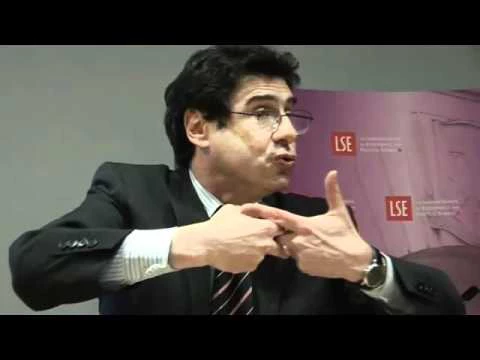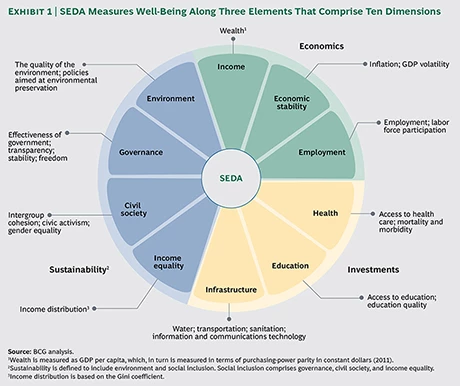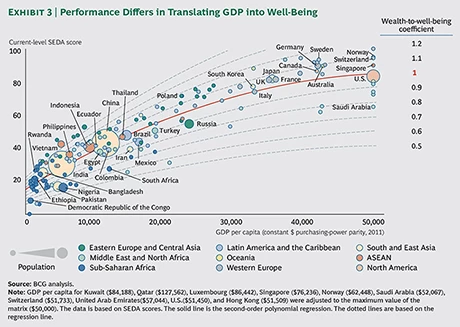Beyond the cold calculus of GDP and TFP and FDI, development is about promoting strong societies as well as propelling powerful economies. But how can we measure societies’ progress toward success? Some may try to calculate “Gross National Happiness” as a yardstick, and some may envision “getting to Denmark” as the ideal end-of-history destiny of development – but are there patterns that reveal how societies can flourish?
Two recent Washington seminars suggest that – by pursuing innovation and inclusion, and by focusing on broad-scale social “well-being” – policymakers can define realistic paths toward development success.
The methodologies used by Harvard economist Philippe Aghion at an International Monetary Fund forum and by former World Bank strategist Enrique Rueda-Sabater at a Center for Global Development discussion may have been different, but their conclusions were in harmony: Societies thrive – in a sustainable way – when inclusion and innovation help expand the circle of opportunity, and when strong governance standards lead to sound civic decision-making.
Taken together, the two seminars’ insights should help inform policymakers’ debate about the Sustainable Development Goals, which are due to be approved in September at the opening of the United Nations General Assembly.
Aghion, at an IMF seminar (sponsored by its Low-Income Countries Strategy Unit) on June 30, approached the topic of “Making Growth Inclusive” by imagining “how to enhance productivity growth while promoting social mobility.” Presenting data from a recent paper on “Innovation and Top-Income Inequality,” which he recently co-authored with an all-star team of economists, Aghion outlined the way that income and wealth inequality have drastically soared in developed countries since the mid-1970s – analyzing trends that by now are sadly familiar to the squeezed middle class, as calculated in the esteemed work of Thomas Piketty, “Capital in the Twenty-First Century.”
Building on that data, Aghion took the inequality-and-inclusion logic several steps further. He lamented the way that “skill-biased technological change” has (in the absence of policy safeguards) provoked societies to stratify along the lines of wealth, income, education and connections. Yet “creative destruction” is inevitable in “a Schumpeterian world,” reasoned Aghion: A significant factor expanding the wealth gap is the same process of continuous economic renewal that helps economies advance. “There is a big [economic] premium to being a superstar innovator,” he asserted, noting that “you can become rich by innovating” – and thus “innovation is a big part of top-1-percent income inequality.”
Philippe Aghion
“Creative destruction is good for social mobility” and broader inclusion, in the long run, because it causes a steady procession of “new innovators to replace old incumbents.” The effect of each wave of innovation is fleeting, especially in a hyperspeed economy: “You get temporary ‘rents’ when you innovate. You don’t get them forever,” because the relentless Schumpeterian process will eventually cause yesterday’s innovators to become, in turn, tomorrow’s has-beens.
The darker danger of entrenched inequality occurs, said Aghion, when incumbent interests use their political power to lobby for the protection of their advantages – whether by pleading for tax-code favors, seeking government-imposed barriers to the entry of new competitors, or purchasing influence with pliant politicians through campaign donations. (In an aside on U.S. politics, Aghion pointed to his paper’s data linking a state’s representation on the congressional Appropriations Committees with its amount of federal favors – a shrewd quantification of the pork-barrel compulsions of Capitol Hill.)
Because innovation promotes social mobility and thus greater inclusiveness, Aghion contended that “innovation is a good guy; lobbying is a bad guy.” So “if you’re for inclusive growth, then you will be against lobbying and [the creation of] entry barriers.”
Focusing simply on present-day inequality is less informative than focusing on social mobility, he asserted. There’s nothing wrong with an economy that bestows ample financial rewards upon genuine innovators who create new products and processes. There is, however, something deeply wrong – and economically growth-inhibiting – with governments that allow no-longer-innovative incumbents to use their political connections to suppress potential competitors.
The IMF panel’s respondents amplified Aghion’s analysis. World Bank economist Daniel Lederman noted that it would be wise to use “the lexicon of ‘inequality of opportunity’,” because some degree of wealth inequality is inevitable (and perhaps even desirable) when individuals’ talent and effort are rewarded with rising incomes. IMF economist Benedict Clements – deploring the “great degree of disparity in ‘equality of opportunity’ ” that now prevails in advanced economies, including the United States – noted that there need be “no conflict between equity and efficiency if you design your policies right.”
Getting policies right – by upholding strong standards of governance – was also one of the underlying themes at a July 21 seminar at the Center for Global Development led by Rueda-Sabater, who is now a senior advisor to the Boston Consulting Group and a visiting fellow among CGD’s strong lineup of scholars. Rueda-Sabater is well remembered at the World Bank for leading a research team’s detailed “scenario planning” analyses that, in 2009, discerned the contours of three possible scenarios for the world in the year 2020.
Presenting a recent BCG report, “Why Well-Being Should Drive Growth Strategies,” Rueda-Sabater outlined an imaginative BCG diagnostic tool: the “Sustainable Economic Development Assessment” (SEDA), which measures the relative well-being of 149 countries by gauging their success in converting wealth into well-being – that is to say, in effectively translating their potential into tangible progress.
Analyzing more than 50,000 datapoints across a wide range of social and economic indicators, SEDA measures “well-being” by examining three aspects of each society – its economics, its investments and its sustainability – that examine 10 areas, including economic stability, health, governance and the environment. SEDA offers two ways to measure each country’s performance: as a snapshot (its current level of well-being) and as a trajectory (the amount of recent progress gained in well-being since 2006). The data-driven analysis gives policymakers another set of criteria to consider as they weigh their policy options.
Good governance was underscored as a key factor by Carol Graham, a Brookings Institution and University of Maryland scholar who analyzed the SEDA findings at the CGD seminar. The author of the well-regarded “The Pursuit of Happiness: An Economy of Well-Being,” she identified a “virtuous cycle” of sound decision-making leading to wise policies that, in turn, produce good social outcomes. Rigorous governance standards are crucial, Graham and Rueda-Sabater agreed, noting the parallel between the countries that scored highest on SEDA’s “Life Satisfaction and Income Per Capita” analysis and those that upheld "getting-to-Denmark"-style good-governance norms: “Any way you slice this, people who live in countries with good governance . . . enjoy higher well-being scores,” with the correlation between sustainability and high-quality economic growth suggesting that there are “institutional roots of sustainability.”
The foreword to the SEDA report, by Nobel Prize-winning Economist A. Michael Spence of New York University, emphasizes the findings’ connection to the SDG debate that will culminate at the United Nations in September. “To pursue well-being effectively, countries need to achieve economic growth that is both socially inclusive and environmentally sustainable. The importance of a decisive, broad-based effort in this regard cannot be overemphasized.” Having co-chaired the Commission on Growth and Development from 2006 to 2009, Spence underscores “the importance of an appropriate rate of investment – including critical public investment” – in strengthening environmental and social sustainability.
Optimists eager for success at the crucial “COP21” conference in Paris in December, where diplomats will try to conclude a global agreement to restrain climate change, will surely applaud Spence’s hopeful outlook: “Fortunately, recent research suggests that energy-intensive, high-carbon growth paths and energy-efficient, low-carbon growth paths are not all that different in the short to medium term – [al]though they diverge dramatically when the high-carbon path fails catastrophically. So a high price need not be paid in terms of growth for shifting to the energy-efficient, low-carbon path if a strategy that sets the right incentives is properly implemented.”
With sustainability now atop the global agenda – and with strong governance always at the heart of successful policymaking – the recent Aghion seminar and BCG “well-being” analysis have set ther stage for the imminent forums that will frame the future: the SDG conference in New York and the climate-change negotiations in Paris. The concept of “well-being” – of economies and societies, of people and the planet – is a valuable lens through which to focus on those urgent priorities.





Join the Conversation